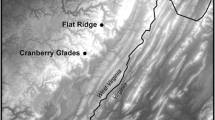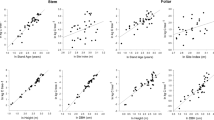Abstract
Difficulty in quantifying rates of biological N fixation (BNF), especially over long time scales, remains a major impediment to defining N budgets in many ecosystems. To estimate N additions from BNF, we applied a tree-scale N mass balance approach to a well-characterized chronosequence of woody legume (Prosopis glandulosa) encroachment into subtropical grasslands. We defined spatially discrete single Prosopis clusters (aged 28–99 years), and for each calculated BNF as the residual of: soil N (0–30 cm), above- and below-ground biomass N, wet and dry atmospheric N deposition, N trace gas and N2 loss, leaching loss, and baseline grassland soil N at time of establishment. Contemporary BNF for upland savanna woodland was estimated at 10.9 ± 1.8 kg N ha−1 y−1, equal to a total of 249 ± 60 kg N ha−1 over about 130 years of encroachment at the site. Though these BNF values are lower than previous estimates for P. glandulosa, this likely reflects lower plant density as well as low water availability at this site. Uncertainty in soil and biomass parameters affected BNF estimates by 6–11%, with additional sensitivity of up to 18% to uncertainty in other scaling parameters. Differential N deposition (higher rates of dry N deposition to Prosopis canopies versus open grasslands) did not explain N accrual beneath trees; iterations that represented this scenario reduced estimated BNF estimates by a maximum of 1.5 kg N ha−1 y−1. We conclude that in this relatively well-constrained system, small-scale mass balance provides a reasonable method of estimating BNF and could provide an opportunity to cross-calibrate alternative estimation approaches.






Similar content being viewed by others
References
Abrams M, Jarrell W, Smith H, Clark P. 1990. Nitrogen accretion in soil and biomass production by three Prosopis species. Agrofor Syst 10:93–7.
Archer S, Boutton T, Hibbard K. 2001. Trees in grasslands: biogeochemical consequences of woody plant expansion. In: Schulze E-D, Harrison M, Heimann M, Holland E, Lloyd J, Prentice IC, Schimel D, Eds. Global Biogeochemical Cycles in the Climate System. San Diego: Academic Press. p 115–38.
Archer S, Scifres C, Bassham C, Maggio R. 1988. Autogenic succession in a subtropical savanna: conversion of grassland to thorn woodland. Ecol Monograph 58:111–27.
Archer S. 1995. Tree-grass dynamics in a Prosopis-thornscrub savanna parkland: reconstructing the past and predicting the future. Ecoscience 2:83–99.
Asner G, Martin R. 2004. Biogeochemistry of desertification and woody encroachment in grazing systems. Geoph Monog Series 153:99–116.
Bai E, Boutton T, Liu F, Wu X, Archer S. 2008. Variation in woody plant δ13C along a topoedaphic gradient in a subtropical savanna parkland. Oecologia 156:479–89.
Bai E, Boutton T, Liu F, Wu X, Archer S. 2013. 15N isoscapes in a subtropical savanna parkland: spatial-temporal perspectives. Ecosphere 4(1):1–17.
Barger NN, Archer SR, Campbell JL, Huang C-Y, Morton JA, Knapp AK. 2011. Woody plant proliferation in North American drylands: a synthesis of impacts on ecosystem carbon balance. J Geophys Res 116:G00K07.
Belnap J. 2002. Nitrogen fixation in biological soil crusts from southeast Utah, USA. Biol Fertil Soils 35:128–35.
Bobbink R, Hicks K, Galloway J, Spranger T, Alkemade R, Ashmore M, Bustamante M, Cinderby S, Davidson E, Dentener F. 2010. Global assessment of nitrogen deposition effects on terrestrial plant diversity: a synthesis. Ecol App 20:30–59.
Boddey R, Peoples M, Palmer B, Dart P. 2000. Use of the 15N natural abundance technique to quantify biological nitrogen fixation by woody perennials. Nutr Cycl Agroecosys 57:235–70.
Boutton TW, Liao JD. 2010. Changes in soil nitrogen storage and δ15N with woody plant encroachment in a subtropical savanna parkland landscape. J Geophys Res 115:G03019.
Creamer CA, Filley TR, Olk DC, Stott DE, Dooling V, Boutton TW. 2013. Changes to soil organic N dynamics with leguminous woody plant encroachment into grasslands. Biogeochemistry 113:307–21.
Eldridge D, Bowker M, Maestre F, Roger E, Reynolds JF, Whitford W. 2011. Impacts of shrub encroachment on ecosystem structure and functioning: towards a global synthesis. Ecol Lett 14:709–22.
Fowler D, Cape JN, Unsworth MH. 1989. Deposition of atmospheric pollutants in forests. Phil Trans R Soc B 324:247–65.
Franco-Pizaña J, Fulbright TE, Gardiner DT. 1995. Spatial relations between shrubs and Prosopis glandulosa canopies. J Veg Sci 6:73–8.
Hartley A, Barger N, Belnap J, Oskin G. 2007. Dryland ecosystems. In: Marschner P, Rengel Z, Eds. Nutrient cycling in terrestrial ecosystems: soil biology, Vol. 10. Berlin: Springer-Verlag. p 271–307.
Hartwig U. 1998. The regulation of symbiotic N2 fixation: a conceptual model of N feedback from the ecosystem to the gene expression level. Perspect Plant Ecol 1:92–120.
Hibbard K, Archer S, Schimel D, Valentine D. 2001. Biogeochemical changes accompanying woody plant encroachment in a subtropical savanna. Ecology 82:1999–2011.
Houghton RA, Hackler JL, Lawrence KT. 1999. The US carbon budget: contributions from land-use change. Science. 285:574–8.
Jha P, Mohapatra KP. 2009. Leaf litterfall, fine root production and turnover in four major tree species of the semi-arid region of India. Plant Soil 326:481–91.
Johnson H, Mayeux H. 1990. Prosopis glandulosa and the nitrogen balance of rangelands: extent and occurrence of nodulation. Oecologia 84:176–85.
Kantola IB. 2012 Biogeochemistry of woody plant invasion: phosphorus cycling and microbial community composition. PhD thesis. Texas A&M University, College Station, TX.
Katz RW. 2002. Techniques for estimating uncertainty in climate change scenarios and impact studies. Cim Res 20:167–85.
Li H, Wu J. 2006. Uncertainty analysis in ecological studies. In: Wu J, Jones KB, Li H, Loucks OL, Eds. Scaling and uncertainty analysis in ecology: Methods and applications. Netherlands: Springer. p 45–52.
Likens GE. 2013. Nutrient Cycles and Mass Balances. In: Biogeochemistry of a Forested Ecosystem. New York: Springer. p 139–61.
Liu F, Wu X, Bai E, Boutton T, Archer S. 2010. Spatial scaling of ecosystem C and N in a subtropical savanna landscape. Glob Change Biol 16:2213–23.
Liu F, Wu X, Bai E, Boutton T, Archer S. 2011. Quantifying soil organic carbon in complex landscapes: an example of grassland undergoing encroachment of woody plants. Glob Change Biol 17:1119–29.
López Villagra G, Felker P. 1997. Influence of understory removal, thinning and P fertilization on N2 fixation in a mature mesquite (Prosopis glandulosa var. glandulosa) stand. J Arid Environ 36:591–610.
Martin R, Asner G, Ansley R, Mosier A. 2003. Effects of woody vegetation encroachment on soil nitrogen oxide emissions in a temperate savanna. Ecol App 13:897–910.
Midwood A, Boutton T, Archer S, Watts S. 1998. Water use by woody plants on contrasting soils in a savanna parkland: assessment with δ2H and δ18O. Plant Soil 205:13–24.
Nelson J, Barnes P, Archer S. 2002. Leaf demography and growth responses to altered resource availability in woody plants of contrasting leaf habit in a subtropical savanna. Plant Ecol 160:193–205.
Northup B, Zitzer S, Archer S, McMurtry C, Boutton T. 2005. Above-ground biomass and carbon and nitrogen content of woody species in a subtropical thornscrub parkland. J Arid Environ 62:23–43.
Pacala SW, Hurtt GC, Baker D, Peylin P, Houghton RA. 2001. Consistent land-and atmosphere-based US carbon sink estimates. Science. 292:2316–20.
R Core Team. 2014. R: A Language and Environment for Statistical Computing, R Foundation for Statistical Computing. Vienna, Austria.
Reichmann L, Sala O, Peters D. 2013. Water controls on nitrogen transformations and stocks in an arid ecosystem. Ecosphere 4(11):1–17.
Risio L, Herrero C, Bogino SM, Bravo F. 2014. Aboveground and belowground biomass allocation in native Prosopis caldenia Burkart secondary woodlands in the semi-arid Argentinean pampas. Biomass Bioenerg 66:249–60.
Rundel P, Nilsen E, Sharifi M, Virginia R, Jarrell W, Kohl D, Shearer G. 1982. Seasonal dynamics of nitrogen cycling for a Prosopis woodland in the Sonoran Desert. Plant Soil 67:343–53.
Shearer G, Kohl D. 1986. N2-fixation in field settings: Estimations based on natural 15N abundance. Aus J Plant Phys 13:669–756.
Shearer G, Kohl D, Virginia R, Bryan B, Skeeters J, Nilsen E, Sharifi M, Rundel P. 1983. Estimates of N2-fixation from variation in the natural abundance of 15N in Sonoran Desert ecosystems. Oecologia 56:365–73.
Sobota DJ, Compton J, Harrison J. 2013. Reactive nitrogen inputs to US lands and waterways: how certain are we about sources and fluxes? Front Ecology Environ 11:82–90.
Soper FM, Boutton TW, Sparks JP. 2015. Investigating patterns of symbiotic nitrogen fixation during vegetation change from grassland to woodland using fine scale δ15N measurements. Plant, Cell Environ 38:89–100.
Soper FM, Boutton TW, Groffman P, Sparks J. 2016a. Nitrogen trace gas fluxes from a semi arid subtropical savanna under woody legume encroachment. Glob Biogeochem Cy 30:614–28.
Soper FM, Groffman P, Sparks J. 2016b. Denitrification in a subtropical, semi arid North American savanna: filed measurements and intact core incubations. Biogeochemistry 128:257–66.
Stevens N, Lehmann CER, Murphy BP, Durigan G. 2017. Savanna woody encroachment is widespread across three continents. Glob Change Biol 23:235–44.
Stock W, Wienand K, Baker A. 1995. Impacts of invading N2-fixing Acacia species on patterns of nutrient cycling in two Cape ecosystems: evidence from soil incubation studies and 15N natural abundance values. Oecologia 101:375–82.
Stoker R. 1997. An Object oriented, spatially explicit simulation model of vegetation dynamics in a south Texas savanna. PhD Dissertation:1–263.
Van Auken O. 2000. Shrub invasions of North American semiarid grasslands. Ann Rev Ecol Syst 31:197–215.
Virginia R. 1986. Depth of root symbiont occurrence in soil. Biol Fertil Soil 2:127–30.
Watts S. 1993. Rooting patterns of co-occurring woody plants on contrasting soils in a subtropical savanna. PhD thesis, Texas A&M University.
Weltz MA, Blackburn WH. 1995. Water budget for south Texas rangelands. J Range Manag 48:45–52.
Wesely ML, Hicks BB. 2000. A review of the current status of knowledge on dry deposition. Atmos Environ 34:2261–82.
Zahran HH. 1999. Rhizobium-legume symbiosis and nitrogen fixation under severe conditions and in an arid climate. Microbiol Mol Biol Rev. 63(968):989.
Zitzer S, Archer S, Boutton T. 1996. Spatial variability in the potential for symbiotic N2 fixation by woody plants in a subtropical savanna ecosystem. J Appl Ecol 33:1125–36.
Acknowledgements
We thank Shauntle Barley and Chase Brett for assistance with sample collection, Kimberlee Sparks for technical support, and David and Stacy McKown for field logistics. This work was supported by the Cornell University Betty Miller Francis’47 Fund for Field Research and the Cornell University Program in Cross-Scale Biogeochemistry and Climate (supported by NSF-IGERT and the Atkinson Center for a Sustainable Future).
Author information
Authors and Affiliations
Corresponding author
Additional information
Author contributions
FMS and JPS formulated the original idea and developed methodology, FMS conducted field sampling, performed sample processing and statistical analysis, FMS and JPS interpreted data, and FMS and JPS wrote the manuscript.
Rights and permissions
About this article
Cite this article
Soper, F.M., Sparks, J.P. Estimating Ecosystem Nitrogen Addition by a Leguminous Tree: A Mass Balance Approach Using a Woody Encroachment Chronosequence. Ecosystems 20, 1164–1178 (2017). https://doi.org/10.1007/s10021-016-0100-1
Received:
Accepted:
Published:
Issue Date:
DOI: https://doi.org/10.1007/s10021-016-0100-1




